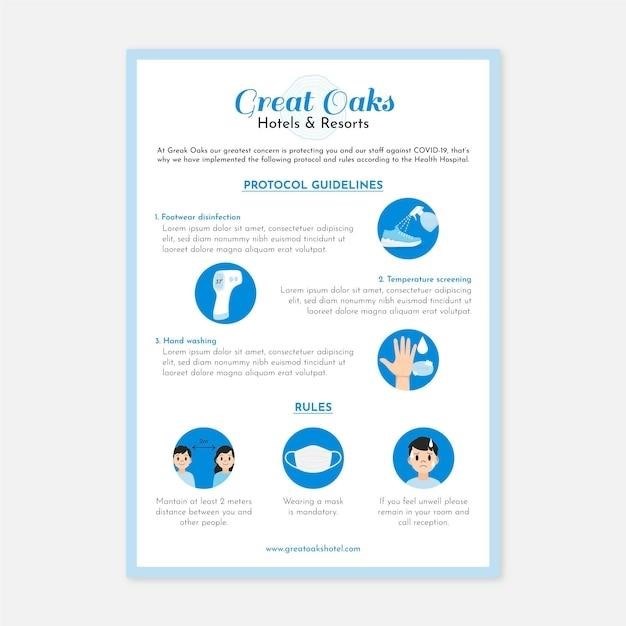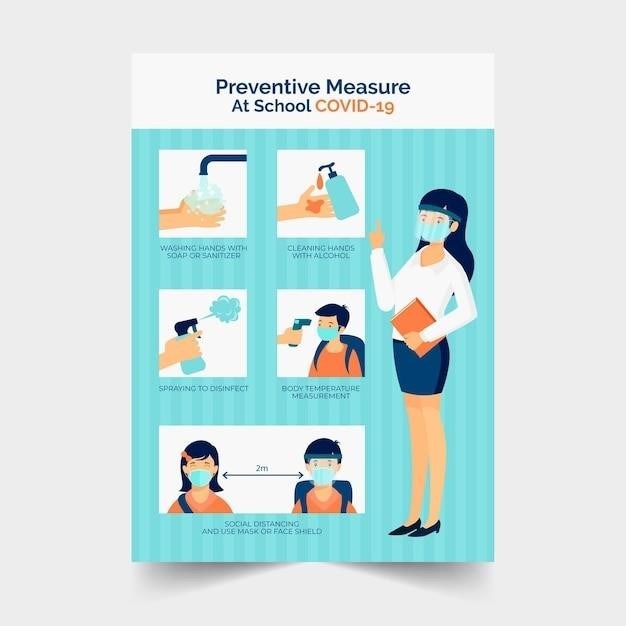
Ear Irrigation Procedure⁚ A Comprehensive Guide
This guide provides a step-by-step approach to ear irrigation, a common procedure for removing impacted earwax or foreign bodies. It covers preparation, necessary equipment, proper technique, post-procedure care, potential complications, and when professional help is needed. Safe and effective ear irrigation requires careful attention to detail.
Preparing for Ear Irrigation
Before commencing ear irrigation, ensure the patient’s comfort and understanding. A thorough explanation of the procedure, including its purpose, steps, and potential sensations, is crucial. Address any anxieties or concerns the patient may have, promoting a calm and cooperative atmosphere. Obtain informed consent, documenting the process according to institutional guidelines. Review the patient’s medical history, noting any contraindications such as ear infections, perforated eardrum, or recent ear surgery. Assess the degree of cerumen impaction through otoscopic examination, determining the suitability of irrigation. Gather all necessary equipment and supplies, ensuring they are clean, sterile, and readily accessible. Prepare the irrigation solution, ensuring it’s warmed to body temperature to enhance patient comfort and minimize discomfort. Finally, select an appropriate irrigation device based on the patient’s age and the nature of the blockage.

Necessary Equipment and Supplies
The essential equipment for ear irrigation includes a suitable irrigation device. Options range from a simple bulb syringe (for children or less impacted wax) to a more controlled system like a 60cc syringe with or without attached tubing. A commercially available ear irrigation system might also be used, offering precise fluid control and minimizing the risk of trauma. Regardless of the chosen device, ensure it’s clean and appropriately sized for the patient’s ear canal. You will also need a basin or container to collect the irrigating fluid. A clean towel or absorbent pads are essential to prevent the fluid from spreading onto the patient’s clothes or the surrounding area. Prepare a solution for irrigation; this might be warm water (body temperature is optimal), saline solution, or a commercially prepared solution depending on the facility protocol and the nature of the blockage. Finally, an otoscope is essential to visualize the ear canal before, during, and after the procedure, enabling assessment of wax removal and detection of any potential complications.
Patient Positioning and Ear Canal Preparation
Correct patient positioning is crucial for a successful and comfortable ear irrigation. The patient should ideally be seated upright, with their head tilted slightly toward the affected ear to facilitate drainage. This position helps gravity assist in the removal of the irrigating solution and any dislodged earwax. For optimal visualization and access to the ear canal, the auricle (outer ear) should be gently straightened. This involves pulling the ear upward and backward for adults and older children, and downward and backward for infants and young children. This maneuver helps to straighten the ear canal, providing a clearer path for the irrigating fluid. Before commencing the irrigation, inspect the ear canal using an otoscope. This allows for assessment of the extent of wax impaction, identification of any potential perforations of the tympanic membrane (eardrum), or presence of foreign bodies. The otoscope examination guides the irrigation process and aids in determining the appropriate technique and fluid volume to be used. Document your findings thoroughly in the patient’s record.
The Irrigation Process⁚ Step-by-Step
Once the patient is positioned and the ear canal is prepared, begin the irrigation process. Using a clean syringe (60cc for adults, smaller for children), fill it with warm, sterile water or a recommended solution (saline, hydrogen peroxide). Ensure the syringe is free of air bubbles to avoid discomfort or injury. Gently insert the tip of the syringe into the ear canal, aiming towards the upper canal wall, not directly inward. Avoid forceful insertion, as this could cause damage. Begin irrigating slowly, allowing the fluid to flow gently into the canal. Observe the outflow; it should be clear initially. Continue irrigating until the outflow becomes clear, indicating successful removal of the obstruction. Pause periodically to check the patient’s comfort level and assess the effectiveness of the irrigation. If the patient experiences pain, dizziness, or nausea, stop immediately. Excessive pressure should be avoided to prevent damage to the eardrum. If the wax is not fully removed in one session, it’s advisable to repeat the process after a short break, allowing the ear to rest.
Using Different Irrigation Devices
Several devices facilitate ear irrigation, each with its advantages and disadvantages. A simple bulb syringe, readily available and inexpensive, is suitable for less impacted cerumen. However, its less precise control might make it unsuitable for delicate situations. Disposable syringes, often coupled with flexible tubing, offer better control over fluid flow and pressure. Their single-use nature promotes hygiene. More advanced electronic irrigators provide precise control over water pressure and temperature, minimizing the risk of discomfort or injury, and are particularly beneficial for stubborn wax impaction. These devices often feature multiple flow settings and a warming mechanism for patient comfort. The choice of device depends on factors such as the level of wax impaction, the patient’s comfort level, and the healthcare setting’s available resources. Regardless of the device used, maintaining proper hygiene and employing a gentle approach are crucial for a safe and effective procedure. Always ensure the device is clean and properly functioning before use.
Post-Irrigation Care and Follow-up
Following ear irrigation, careful post-procedure care is essential to prevent complications and promote healing. Gently dry the outer ear using a soft towel, avoiding forceful wiping that could irritate the delicate ear canal. Avoid getting water in the ear for at least 24 hours to allow the canal to dry completely and reduce the risk of infection. Observe the ear for any signs of redness, swelling, pain, or discharge. These could indicate an infection or other complication. If discomfort persists or worsens, or if you notice any unusual symptoms, seek immediate medical attention. Keep the ear clean and dry to minimize the chance of infection. For several days after the procedure, avoid swimming, showering, or other activities that might introduce water into the ear canal. Should any concerns arise, consult your healthcare provider for advice and follow-up care. Regular ear hygiene practices can help prevent future wax buildup and the need for repeated irrigation.
Complications and Contraindications
Ear irrigation, while generally safe, carries potential risks; One major concern is infection. Introducing water into the ear canal can create a breeding ground for bacteria if not performed aseptically or if the ear canal is already inflamed. Another potential complication is perforation of the tympanic membrane (eardrum), which can lead to hearing loss, pain, and dizziness. This is more likely if there’s a pre-existing condition or if the irrigation is performed forcefully or incorrectly. Patients with ear infections, tubes in their eardrums, or a history of ear surgery should avoid ear irrigation as it could worsen their condition. Vertigo (dizziness) and nausea are also possible, particularly if water enters the inner ear. Individuals with a perforated eardrum, suspected infection, or excessive sensitivity to water in the ear should not undergo this procedure. Improper technique can also cause damage to the ear canal and discomfort. Always consult a healthcare professional before attempting ear irrigation, particularly if you have any concerns or pre-existing conditions.
When to Seek Professional Medical Advice
While ear irrigation can effectively remove earwax, certain situations necessitate professional medical attention. If you experience persistent ear pain, especially sharp pain, after attempting irrigation, seek immediate medical advice. This could indicate a perforated eardrum or other serious issue. Similarly, if you notice any bleeding from the ear, even a small amount, it requires prompt medical evaluation. Hearing loss following irrigation, whether partial or complete, is a significant concern and warrants a doctor’s visit for proper diagnosis and treatment. Signs of infection, such as increased ear pain, pus or discharge from the ear, fever, or swelling around the ear, necessitate immediate medical attention to prevent complications. If you experience dizziness or vertigo that persists after ear irrigation, it is crucial to consult a healthcare professional. These symptoms could signal a more serious problem. If home irrigation fails to remove the earwax or foreign object, or if the blockage worsens, it’s best to seek professional help for appropriate medical intervention. Never hesitate to consult a physician if you are uncertain about the procedure or if any concerning symptoms develop.
Alternative Methods of Earwax Removal
Several alternatives to ear irrigation exist for earwax removal, each with its own advantages and disadvantages. Ear candling, a method involving inserting a hollow candle into the ear canal to supposedly draw out wax, lacks scientific evidence of effectiveness and carries a risk of burns or injury. Manual removal by a healthcare professional using specialized instruments is a safe and effective option, particularly for individuals with sensitive ears or conditions that contraindicate irrigation. This approach allows for precise removal of wax without the potential discomfort or complications associated with irrigation. Over-the-counter earwax removal drops, often containing ingredients like carbamide peroxide or mineral oil, can soften and loosen earwax, facilitating its natural removal. These drops are generally safe for home use but should be employed according to the product instructions. Microsuction, a procedure performed by a healthcare professional using a small suction device, is another effective method for removing impacted earwax; It is particularly beneficial for individuals with sensitive ears or those who have experienced difficulties with other methods. The choice of method depends on individual needs and preferences, always consulting a healthcare professional for guidance is recommended.
Choosing the Right Irrigation Solution
Selecting the appropriate irrigation solution is crucial for a safe and effective ear irrigation procedure. Plain lukewarm water is often sufficient for removing earwax, ensuring it’s comfortably close to body temperature to avoid dizziness or discomfort. However, for individuals with particularly stubborn wax impaction, adding a small amount of saline solution (saltwater) can aid in the process. Saline’s natural properties can help loosen and dissolve the wax, facilitating its removal during irrigation. Some healthcare professionals may recommend using a cerumenolytic agent, a solution specifically designed to soften and break down earwax. These agents, often available over-the-counter, contain ingredients like carbamide peroxide or docusate sodium. It’s important to note that while these solutions can be effective, they should always be used according to the product instructions and under the guidance of a medical professional. Never use solutions that are too hot or too cold, as this can cause discomfort or even damage to the delicate structures within the ear canal. The choice of solution should always be made in consultation with a healthcare professional to ensure patient safety and the most effective outcome for the procedure.
Maintaining Ear Hygiene to Prevent Future Impaction
Preventing future earwax impaction relies on establishing and maintaining good ear hygiene practices. Avoid using cotton swabs or other objects to clean deep inside your ear canal, as this can push wax further in and potentially damage the delicate ear drum. Instead, focus on cleaning the outer ear with a soft, damp cloth. Gentle wiping of the visible outer ear can remove excess wax and debris. For those prone to earwax buildup, periodic use of ear drops designed to soften wax can be beneficial. These drops, typically containing mineral oil or other softening agents, can help loosen the wax, making it easier to naturally drain. Consult with a healthcare professional to determine the appropriate frequency and type of ear drops for your specific needs. Regular ear check-ups, especially for individuals with a history of earwax issues, can help detect potential impaction early. Early detection allows for less invasive removal methods and helps prevent the need for more extensive procedures like irrigation. By adopting these preventative measures, you significantly reduce the risk of future earwax impaction and maintain healthy ear function.